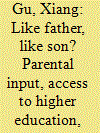| Srl | Item |
| 1 |
ID:
187826


|
|
|
|
|
| Summary/Abstract |
This paper studies the role of parental input in university access in the context of a 10-fold expansion of China's higher-education sector since 1999. Using a Logit regression, we find that an increase in a parent's education level significantly raises their child's probability of entering university. Moreover, the effects of parental involvement and children's trust towards their parents on university entrance are highly significant. The results are robust to Probit and Linear-Probability-Model specifications. Heterogeneity analysis reveals that for rural and/or worse-educated families, parental involvement significantly affects the child's access to university, while for urban and/or better-educated families, the child's own study attitude is key for progression to university. To address the confounder of genetic inheritance, we use regression discontinuity and two-stage least squares and find that the nine-year compulsory education policy launched in 1986 not only increased the education years of the first generation by about 1.66 years, but has also had a lasting effect by raising the second generation's probability of access to university by 11.77%.
|
|
|
|
|
|
|
|
|
|
|
|
|
|
|
|
| 2 |
ID:
192978


|
|
|
|
|
| Summary/Abstract |
This mixed-methods study is the first to explore the association between fee-charging private supplementary tutoring (PT) participation and access to higher education in Kazakhstan from the perspectives of Grade 11 students during the COVID-19 pandemic. Guided by the work of Entrich in 2018, a four-dimensional model of educational inequality in PT, this study found that the scale of PT had expanded during the pandemic, with 75.06% (623 out of 830) of participants engaged in PT, mainly to excel in the university entrance examinations and gain a state grant at their preferred university in Kazakhstan. Also, 73.8% of the students spent 40,000 tenge (US$88) or less on PT per month. Although participants’ families prioritized boys for providing PT services, most participants neither agreed nor disagreed that PT was a financial pressure on their families, probably because the majority attended group tutoring delivered at tutorial centres, and this mode of tutoring reduced the unit cost and gave them the attention they needed from their tutors. The 30 interviewees had positive attitudes towards PT, but some mentioned a few of its disadvantages, including the spread of less qualified, costly tutors due to the unregulated PT market in Kazakhstan. This study suggests pedagogical implications and areas for ongoing research.
|
|
|
|
|
|
|
|
|
|
|
|
|
|
|
|